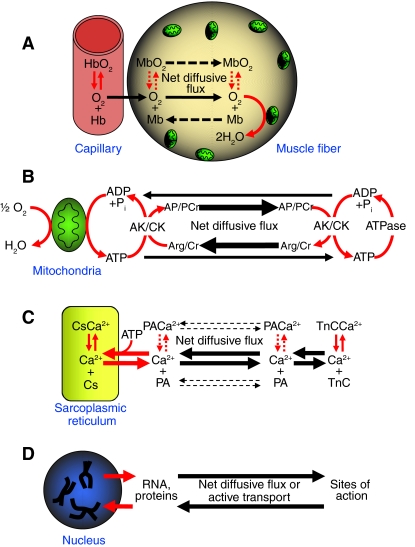Fig. 1.
Examples of reaction–diffusion processes in muscle. (A) O2 diffusion entails reversible binding with hemoglobin (Hb) or another blood pigment type, and with myoglobin (Mb) in some fiber types. (B) Diffusion of ATP to cellular ATPases involves the reversible transfer of a phosphoryl group from ATP to an acceptor molecule such as creatine (Cr) or arginine (Arg), forming the phosphagen phosphocreatine (PCr) or arginine phosphate (AP), respectively. Phosphagen kinases, such as creatine kinase (CK) or arginine kinase (AK) catalyze these reactions. (C) Ca2+ is released from the sarcoplasmic reticulum (SR) upon muscle stimulation and must diffuse to and bind myofibrillar troponin C (TnC) to activate contraction. Relaxation entails the uptake of Ca2+ into the SR, where reversible binding to calsequestrin (Cs) may occur. In some fiber types, parvalbumin (PA) reversibly binds Ca2+ that is in the sarcoplasm. In addition, ATP binds Ca2+ and may further facilitate diffusion (not shown). (D) Transcription and translation entails diffusive flux of nuclear products to various sites of action in the cell. In all cases, the red arrows indicate protein-mediated binding, transport or catalysis, while the black arrows indicate diffusion. The thickness of the arrows indicates the relative importance of the diffusive pathway. Dashed lines indicate that Mb and PA are not present in all fiber types.

